Over the last decade, Sarajevo has become an increasingly popular tourist destination. Make the most of a three-day visit to Sarajevo and discover the multicultural history, ancient craftsmanship, famed hospitality, culinary traditions, and the controversial heritage of the siege that devastated the city during the 1990s.
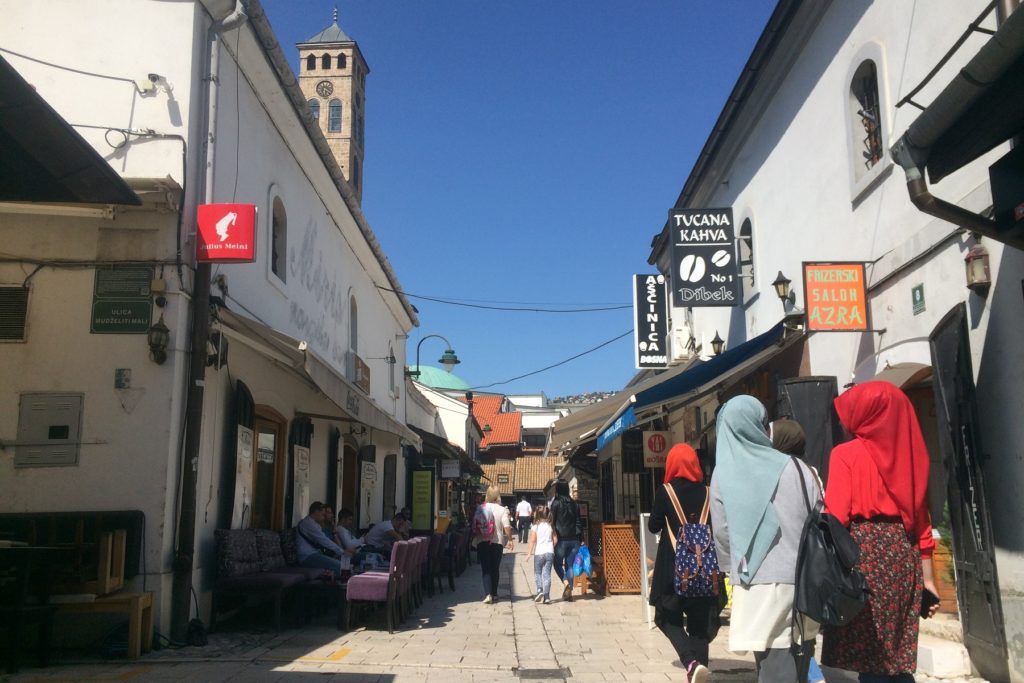
The old town and Sarajevo’s Old Clock Tower (Photo: Andrea Gambaro)
Visitors in Sarajevo are naturally drawn to the city centre, located at the foot of the hills and stretched along the Miljacka river. The different urban landscapes that form this relatively-small area stand next to each other in a peculiar equilibrium, showing neither contrast nor full harmony. Such equilibrium might reveal something about the spirit of this ancient city, into which visitors are welcome to delve.
The city centre and the old bazaar
The pedestrian Ferhadija Street bisects the centre from east to west, starting where the Eternal Flame remembers the victims of World War Two. The first section of the street shows typical Middle European features, reminiscent of the Austro-Hungarian period. One might think of it as a small-scale Vienna, with elegant buildings and boulevards that seem to hide a café behind every corner.
Where the Ferhadija turns into Sarači Street, the surroundings change noticeably. The streets get narrower, their layout more irregular, and the shorter buildings disclose the hills that surround Sarajevo in the background. This is the Baščaršija, the old bazaar, true heart of the city and reflection of its Ottoman roots. In addition to its charm and historical interest, it is remarkable how this area has managed to become a tourist hub without losing its authentic spirit.
Mosques, courtyards, museums and restaurants populate the old town, while many workshops provide quality souvenirs made according to ancient craftsmanship (especially those that line up Kazandžiluk, the Coppersmith street). But the best way to experience the Baščaršija is by finding a nice spot to sip Bosnian coffee and watch locals and tourists go about their business.
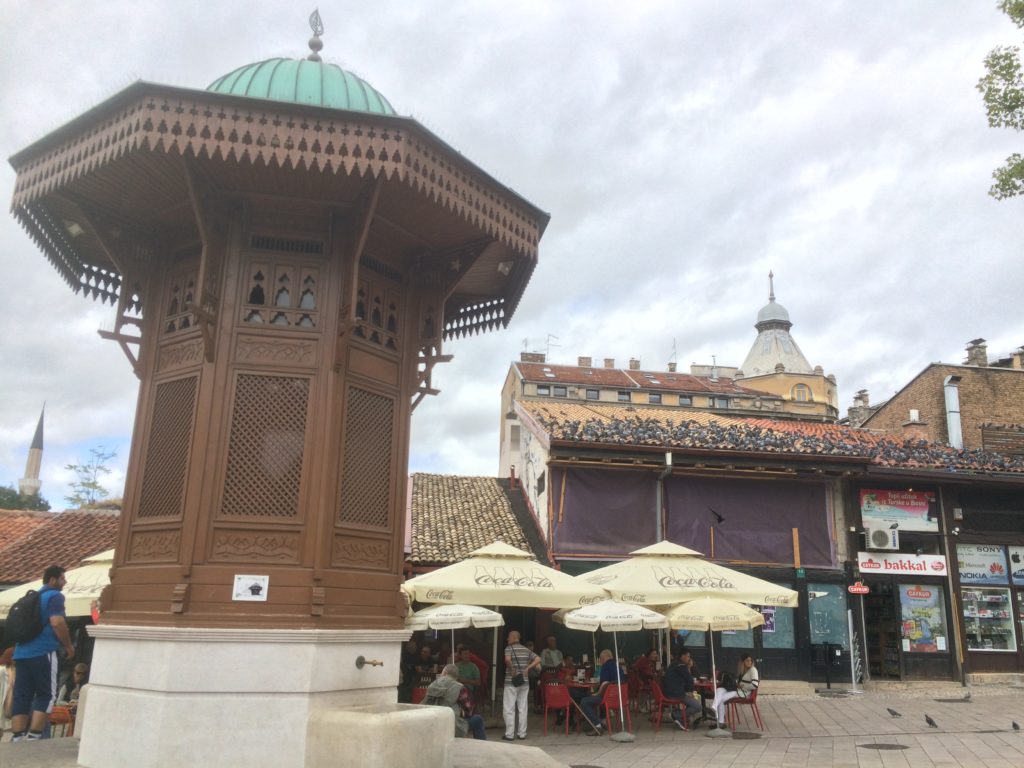
The Sebilj fountain in Baščaršija Square, also known as Pigeon Square (Photo: Andrea Gambaro)
The Jerusalem of Europe
The diversity of religious buildings located in this part of the city explains why Sarajevo is often referred to as the ‘Jerusalem of Europe’. It takes less than ten minutes to walk from the Serbian-Orthodox cathedral to Gazi Husrev Bey’s Mosque, passing by the Catholic cathedral and the Old Jewish Temple (today a museum).
Such proximity reflects the multicultural streak of Sarajevo, which has historically been home to Catholics, Serbian-Orthodox, Jews and Muslims (today largely predominant). Not in many European cities, if any, can one hear the Muezzin’s call to prayer resound together with the ringing bells, at certain times of the day.
In addition to those mentioned above, other noteworthy religious sites include the Emperor’s Mosque, Baščaršija Mosque, Aškenazi Synagogue, the Old Orthodox Church, the Franciscan Church of St. Anthony, Ali Pasha’s Mosque, and Bakr-Baba’s Mosque.

The new and the old (Photo: Andrea Gambaro)
War history
But religions and ethnicities also played a role in marking the line between besiegers and besieged, within the complex context of the Balkan Wars. From 1992 to 1996, Sarajevo endured the longest siege in modern history, as life was made intolerable by the Serbian forces’ shelling and sniper fire. Over 11,000 people were killed during the siege, including 5,000 civilians.
Over twenty years later, signs of the war are still scattered across the city. If bullet holes still scar many buildings, the red ‘Sarajevo Roses’ signal the spots where the grenades left their peculiar flower-shaped marks. At the central marketplace (Markale), a commemorative plaque remembers the victims of two mortar shells that hit the market during opening times in 1994 and 1995.
The War Childhood Museum takes the visitor on a touching journey through a collection of items donated by those who lived through the siege in their young age, each item linked to a particular memory shared by the original owner. The ‘Tunnel of Hope’, which served as the only connection between Sarajevo and the rest of the world, offers another immersive experience of the war.
Another symbolic location is the Vijećnica, the town hall and former national library. Destroyed by shelling in August 1992, it became a sadly iconic image of the war the following day, as musician Vedran Smailović played its cello among the rubble that was left of the building. As the library went up in flames, at least one person died while trying to save the many books and volumes that were turning into ashes, along with their cultural significance.
The Vijećnica was rebuilt in the original pseudo-Moorish style and reopened in 2014. It is no longer a public library, but it hosts art and history exhibitions.
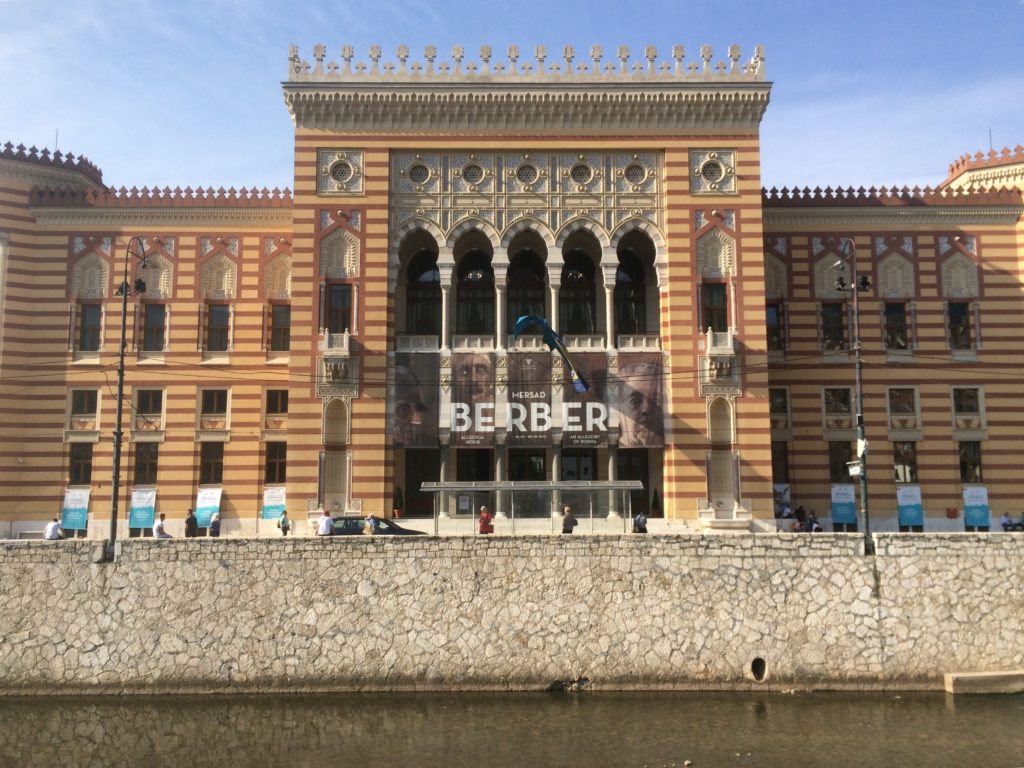
The Vijećnica was originally built by the Austro-Hungarian government in 1894 (Photo: Andrea Gambaro)
The riverside and the bridges of Sarajevo
Facing the river, the Vijećnica is well placed for a stroll along the bank, where an overview of the many bridges of Sarajevo spans different styles and eras. Ancient bridges like Šeher-ćehajina Ćuprija and Ćumurija Bridge hide curious stories and legends, while the modern Festina Lente offers a striking scenic effect at night.
Most tourists will gather at the Latin Bridge. Here is where Gavrilo Princip assassinated Archduke Franz Ferdinand and his wife, Sofie, on 28 June 1914, fuelling the tensions that led to World War One only a month later. The episode is well explained at the Museum Sarajevo located next to the bridge, which also provides insight on the city during the Austro-Hungarian rule.
Further along the river is the Academy of Fine Arts, originally built to serve as an Evangelical Church and considered one of Sarajevo’s loveliest buildings.
Other major cultural institutions in town include the National Gallery and the National Museum. Along with treasures and testimonies from Bosnia and Herzegovina’s past, the National Museum displays the Haggadah, a priceless book brought to Sarajevo by the Sephardic Jews who fled Spain at the end of the 15th century.
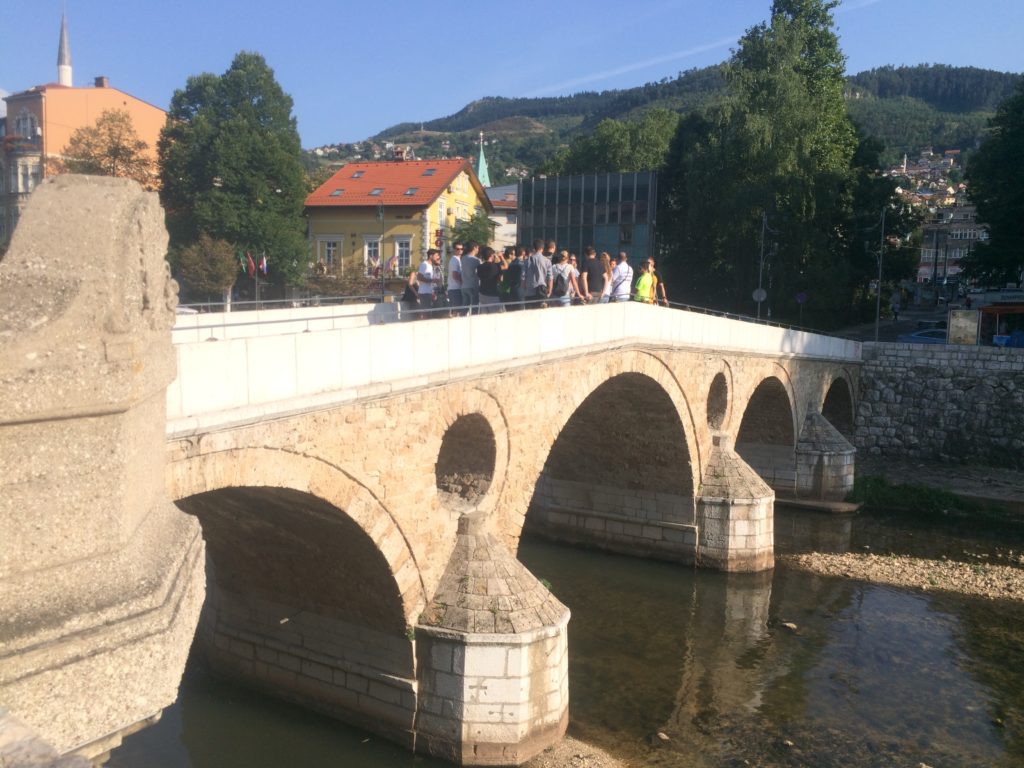
The Latin Bridge (Photo: Andrea Gambaro)
Up the hills
To explore the hills that surround the city, walk up the narrow streets and dive into the mahalas. These residential areas historically included a mosque, a mekteb (religious school), a harem, a public fountain, a bakery and a shop. While walking here, keep your camera at the ready to capture the quaint corners and vantage points overlooking Sarajevo.
Some of the architectural gems that can be found in this part of town are the Hajji Sinan’s Tekke, Saburina House, Alifakovac Cemetery, the Tomb of The Seven Brothers, and The Old Jewish Cemetery.
The Yellow Fortress is where, during the Islamic month of Ramadan, a cannon fired at sunset announces the end of the fast, but the view it offers is spectacular all day long. A little further away is the White Fortress, which might be worth reaching by taxi (it’s a 30-minute walk uphill from the city centre).
Definitely out of walking distance is the Olympics Museum, which celebrates the Winter Olympic Games that took place in Sarajevo in 1984.
Say goodbye
A stay in Sarajevo should finish back in the old town. Seek out Sebilj fountain in Baščaršija square, some say a sip of its fresh water guarantees you’ll visit the city again one day.
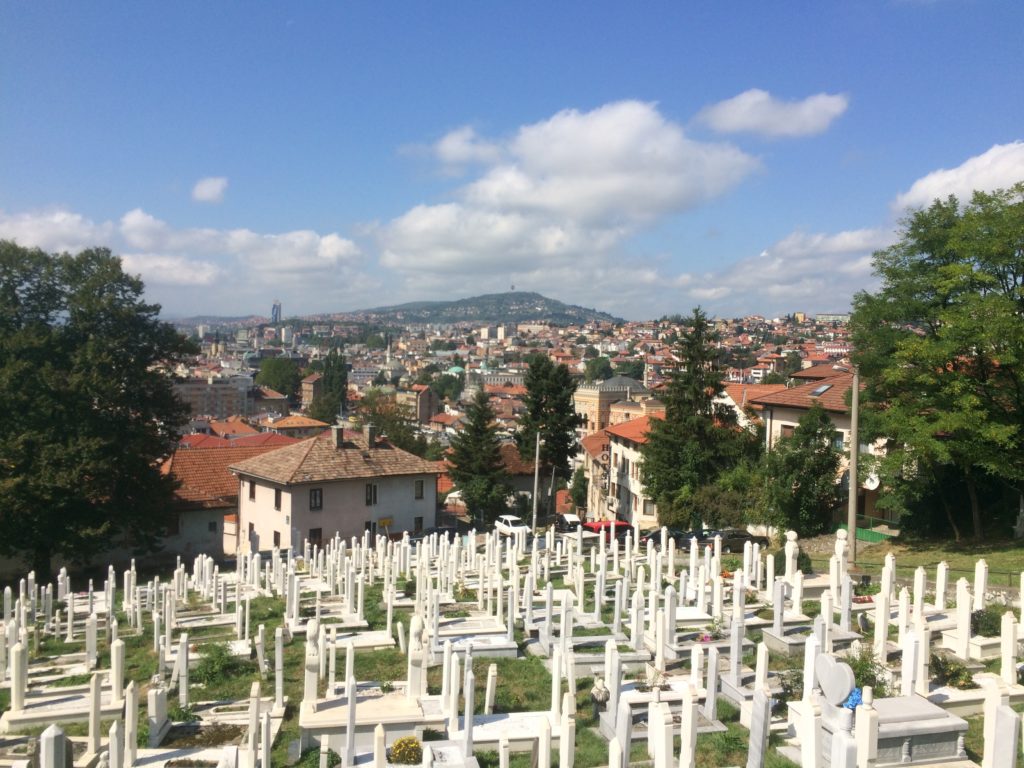
The view over Sarajevo from one of the many cemeteries that dot the hills around the city (Photo: Andrea Gambaro)
Accommodations
Quite unlike any other hostel, War Hostel Sarajevo (Hrvatin 21, Sarajevo) is an immersive experience in war-torn Sarajevo. It is run by a family who survived the war, furnished mostly with wartime memorabilia, and enlivened by a wide range of cultural activities related to the war. As such, it is more an educational project than just a place to stay, let alone a party hostel. Designed for solo travellers and small groups, the rooms can be booked only by contacting the hostel directly via email.
Balkan Han Hostel (Dalmatinska 6, Sarajevo) is a budget party hostel for young travellers and people looking for a relaxed and easy-going atmosphere. Conveniently located near Ferhadijia Street, the hostel offers colourful rooms, a great rear garden and a bar where ending up with a shot of rakija in hand tends to be far too easy. It is one of the best options in town to meet other travellers and experience Bosnian hospitality.
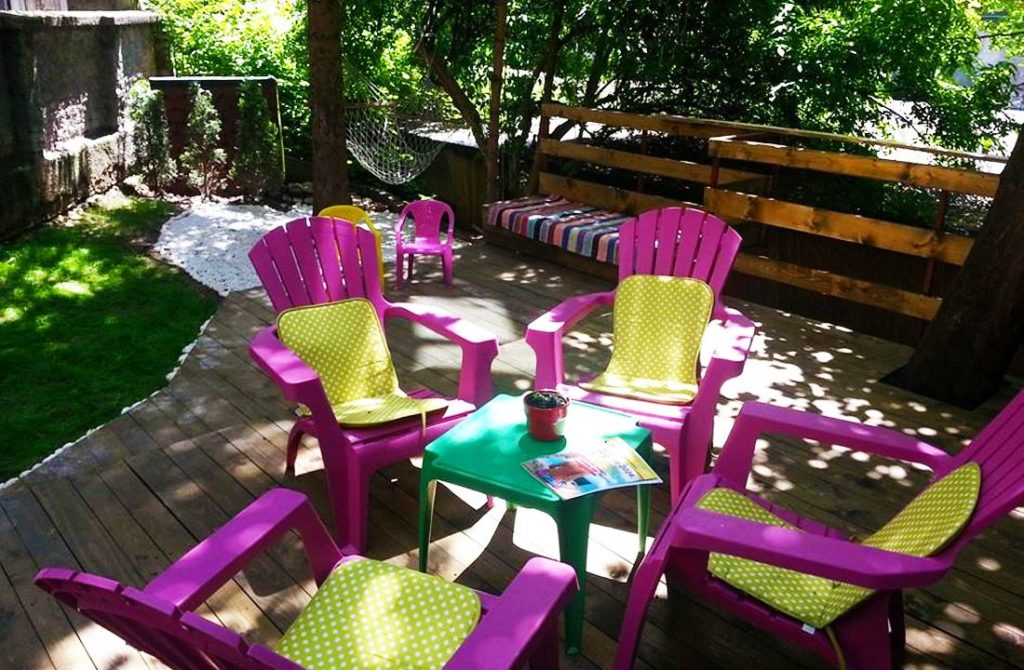
The garden at Balkan Han Hostel (Photo: Balkan Han Hostel)
Hotel Old Sarajevo (Bravadžiluk 38, Sarajevo) describes itself as a heritage hotel where “traditional charm meets modern design and superior comfort”. Located in the heart of the old town, the hotel is only metres away from the Town Hall, the souvenir street (Kazandžiluk), Pigeon Square and all the other amenities offered by the Baščaršija; the ideal choice for a comfortable and pleasant stay.
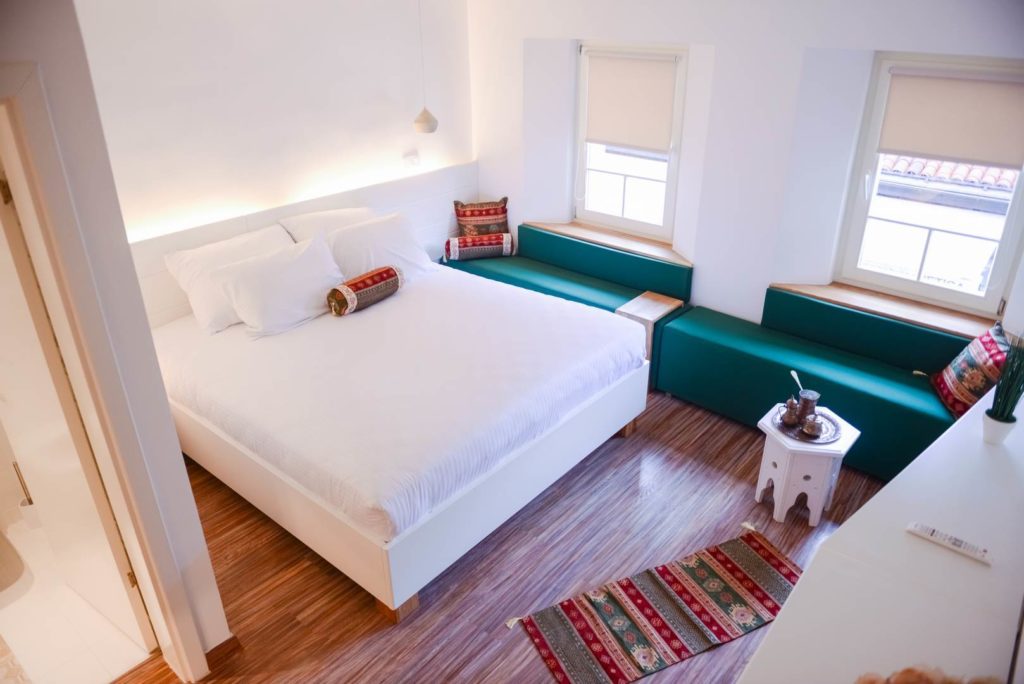
Hotel Old Sarajevo mixes tradition and design (Photo: Hotel Old Sarajevo)
Another central accommodation, less than five minutes’ walk from the old town, Hotel Boutique 36 (Safvet-bega Bašagića 36, Sarajevo) seeks to provide first-class services and comfort. The hotel has recently undergone renovation, gaining a stylish and fashionable twist. It is suitable for business and pleasure trips alike, and provides a free shuttle service from and to the airport.
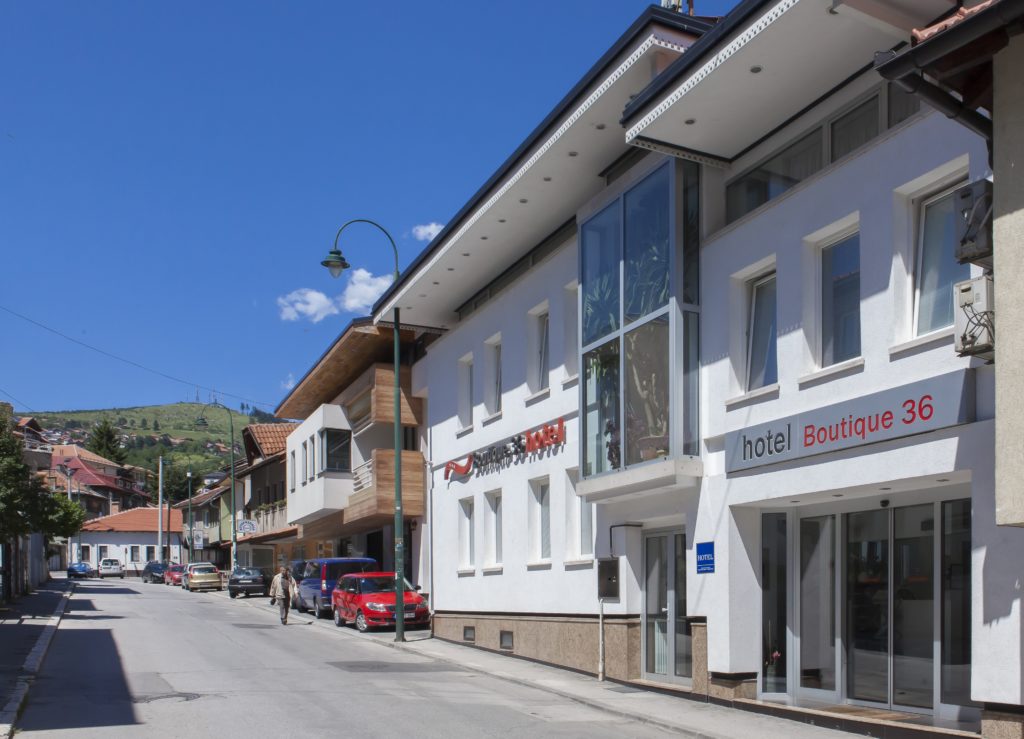
Outside Hotel Boutique 36 (Photo: Hotel Boutique 36)
Hotel Michele (Ivana Cankara 27, Sarajevo) is a boutique hotel combining tradition and modern features. It is the right place to go for those in search of high-quality service, without renouncing the perks of a small, family-run hotel. Located in a quiet residential area, in one of the typical narrow streets that run up the hill, the hotel is within walking distance from the old town.
Modern and stylish, City Boutique Hotel (Mula Mustafe Baseskije 2, Sarajevo) offers amenities and comforts that will make your stay in Sarajevo as pleasant as you can imagine it to be. It has a particularly interesting health policy, which includes healthy breakfast menus, anti-allergy bedding and eco-friendly laundry. Business travellers are also welcome, as the hotel features two conference halls.
Restaurants, cafés and bars
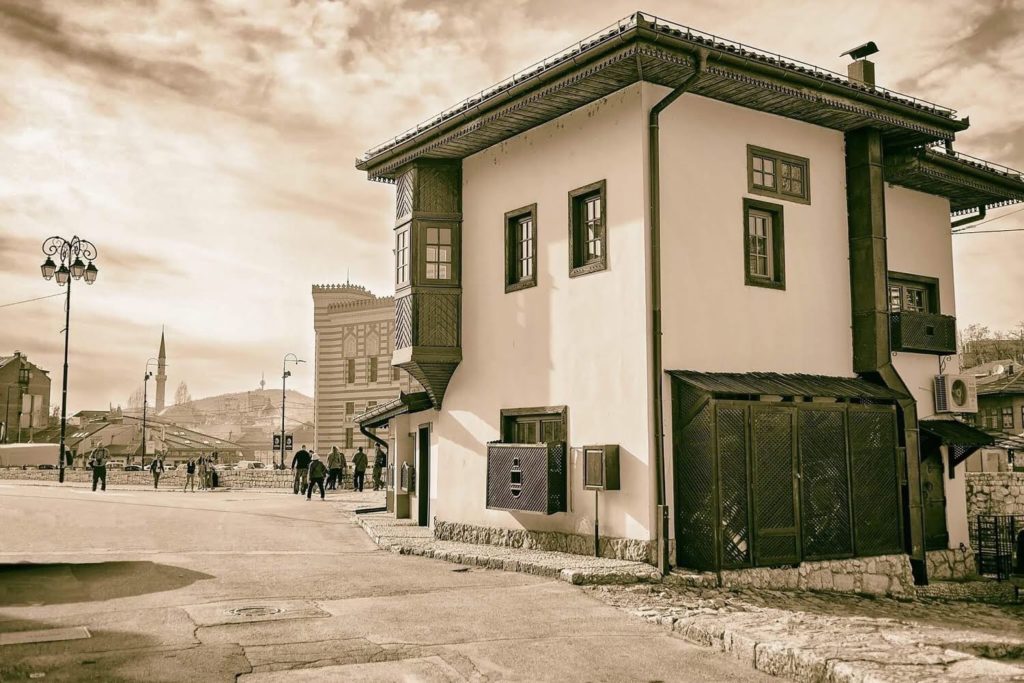
It took a good deal of convincing to move Inat kuća to the other side of the river (Photo: Inat kuća)
A restaurant, a little museum, an example of Bosnian stubbornness. Inat kuća (Veliki Alifakovac 1, Sarajevo) is many things at once. Even if you end up eating outside, overlooking the Vijećnica, make sure to nose around the memorabilia displayed inside, explore the rooms upstairs, and learn about the curious history of this house, which once stood on the other side of the river. Then, of course, focus on the traditional Bosnian specialities that will crowd the table.
Perhaps the most popular dish in Sarajevo, börek is a baked, thin pastry filled with tender and juicy minced meat (it also comes filled with spinach, cheese or potatoes). Although the old town swarms with börek bakeries, our pick is the Buregdžinica Bosna (Bravadžiluk 11, Sarajevo), which also serves delicious delights and Bosnian coffee. Try börek for breakfast with ayran (a yoghurt-based beverage). That’s what the locals do.
Similar to above, but referred to as ćevapi, grilled minced-meat sausages can be described as the traditional Bosnian fast food. At Ćevabdžinica Željo (Kundurdžiluk 19, Sarajevo), all you have to do is take a seat, choose some side dishes, and decide how many ćevapi you want to fill the pita bread with.
At Kibe Mahala (Vrbanjuša 164, Sarajevo), authentic Bosnian food comes with a stunning view of the valley where Sarajevo is nestled. Come here to enjoy the national cuisine at its best, along with a fine selection of regional wines. Consider trying the spit-roasted lamb; one of the most representative dishes of the Bosnian tradition.
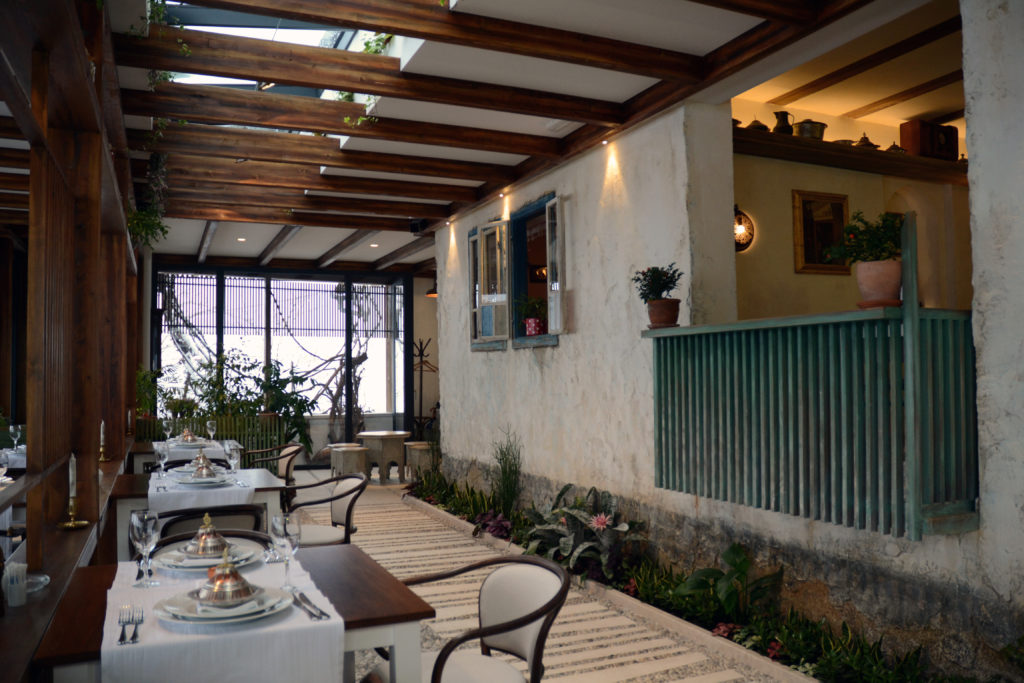
Kibe Mahala’s terrace (Photo: Kibe Mahala)
Named after the Italian opera tenor Enrico Caruso, Karuzo (Dženetića čikma BB, Sarajevo) opened in 1999 to become the first vegetarian-vegan restaurant in Sarajevo, and it has been widely celebrated ever after. Chef Saša Obućina himself will welcome you and take orders, trying to make the culinary experience as tailored as possible to each customer’s preferences (there is also a no-smoking policy, unlike at most other places in town).
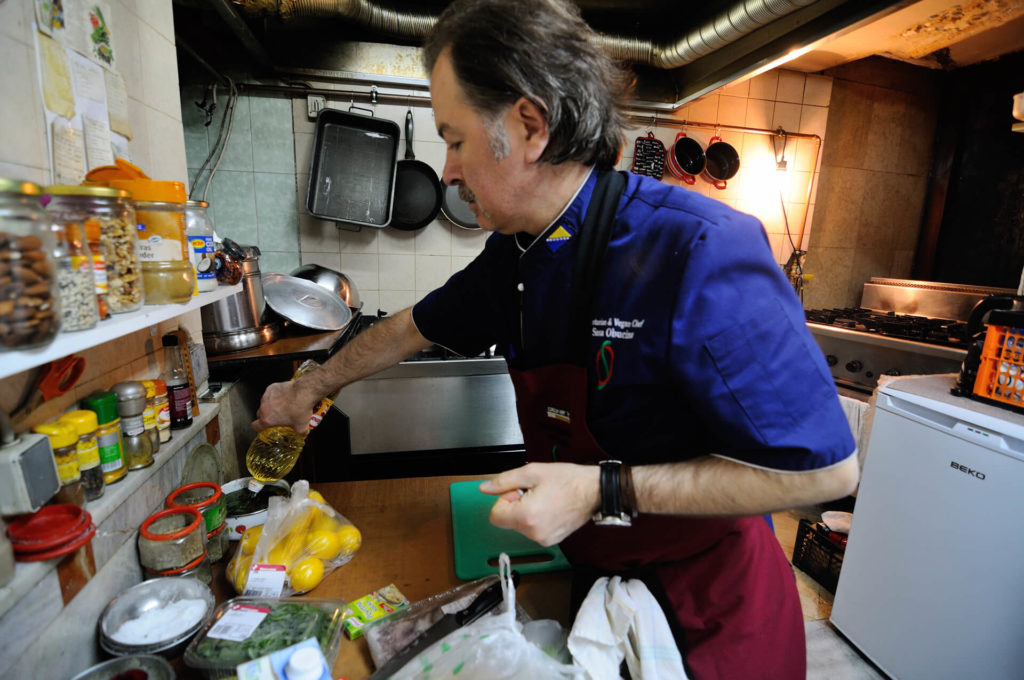
Chef Saša Obućina at work (Photo: Karuzo)
Look for the Italian and Spanish flags at the entrance and you’ll find La Cava (Kundurdžiluk 1, Sarajevo), a cocktail and wine bar located in the old town. Here, the menu offers a selection of over 50 cocktails, aperitivo snacks and nibbles, and an assortment of local and international wines. It seems that the locals struggle to resist La Cava’s mojitos, especially on sunny days.
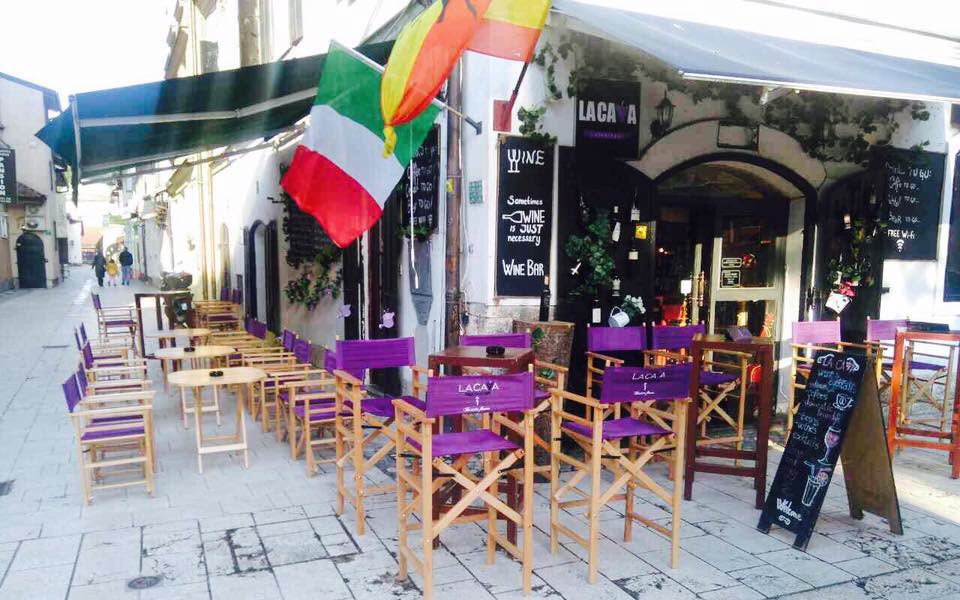
Flags outside La Cava’s entrance (Photo: La Cava)
Hidden behind the Historical Museum of Bosnia and Herzegovina, in the university area, Caffe Tito (Zmaja od Bosne 5, Sarajevo) is a picturesque café completely dedicated to Marshal Josip Broz Tito. Its large garden and Tito-themed interior rooms are mostly crowded with students and young people, serving both as a café and a club. There is also a programme of live music events.
Smoking shisha is one of the best ways to slow down, switch off the tourist mode, and spend a relaxing time in the old town. Damask (Trgovke 29, Sarajevo) is a modern shisha bar, but many others can be found in the small squares and hidden corners of the Baščaršija. A coffee, a tea or a refreshing drink will be a perfect pairing for your smoking session.
Franz and Sophie (Petrakijina 6, Sarajevo) is the ultimate tea room in Sarajevo. It showcases over 120 kinds of high-quality tea, purchased from renowned and prestigious tea producers, along with an interesting range of gadgets. This is a must-go place for tea lovers, whether they are in search of a takeaway souvenir or of a quiet spot to experience an innovative and refreshing side of the city.
Zlatna Ribica (Kaptol 5, Sarajevo) is one of those places one regrets not having visited, after finding out it existed when the holiday is over. Now that you know about it, use it as an excuse to take a break from walking around the city. The quirky décor mixing different styles and periods, background jazz music and dim lighting will likely make your break a little longer.
Shopping
Bazerdžan (Veliki Ćurčiluk 12, Sarajevo) is a concept store promoting local designers and artists, who look at the Bosnian traditions in a modern and fashionable way. Whether you’re looking for clothing, jewellery or accessories, a visit here is highly recommended.
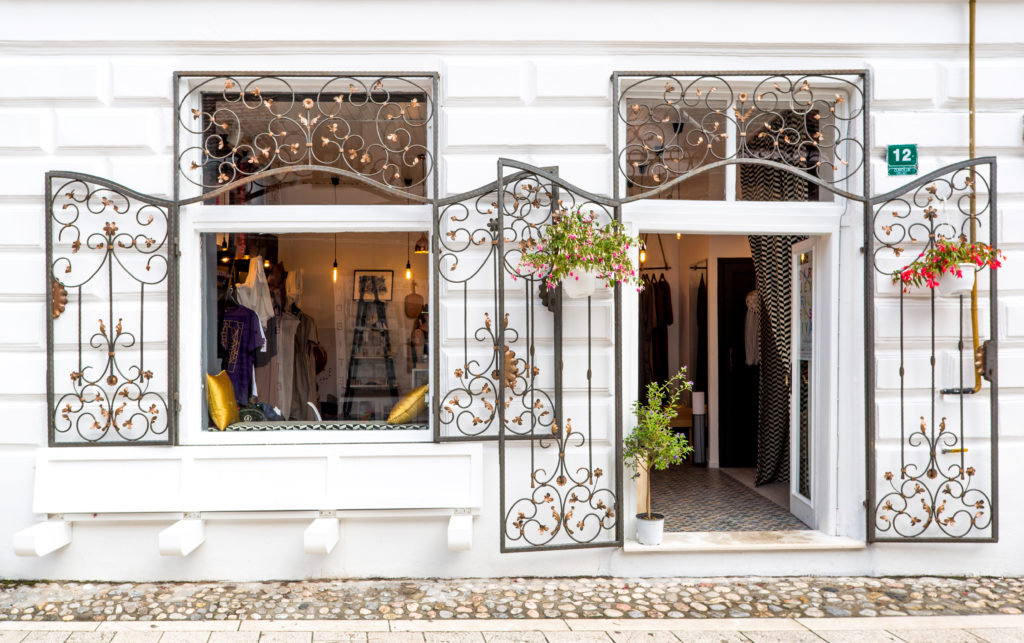
Bazerdžan’s entrance (Photo: Bazerdžan)
BHcrafts (Ćurčiluk veliki 8, Sarajevo) was started in 1995 by Lejla Radoncic, the director of a refugee camp during the war. Each souvenir, household, garment and accessory sold here is produced by a woman who was once a refugee in that camp, and you’ll find their name on the label. BHcrafts is the first recognized social entrepreneurship and licensed fair trade producer in Bosnia and Herzegovina.
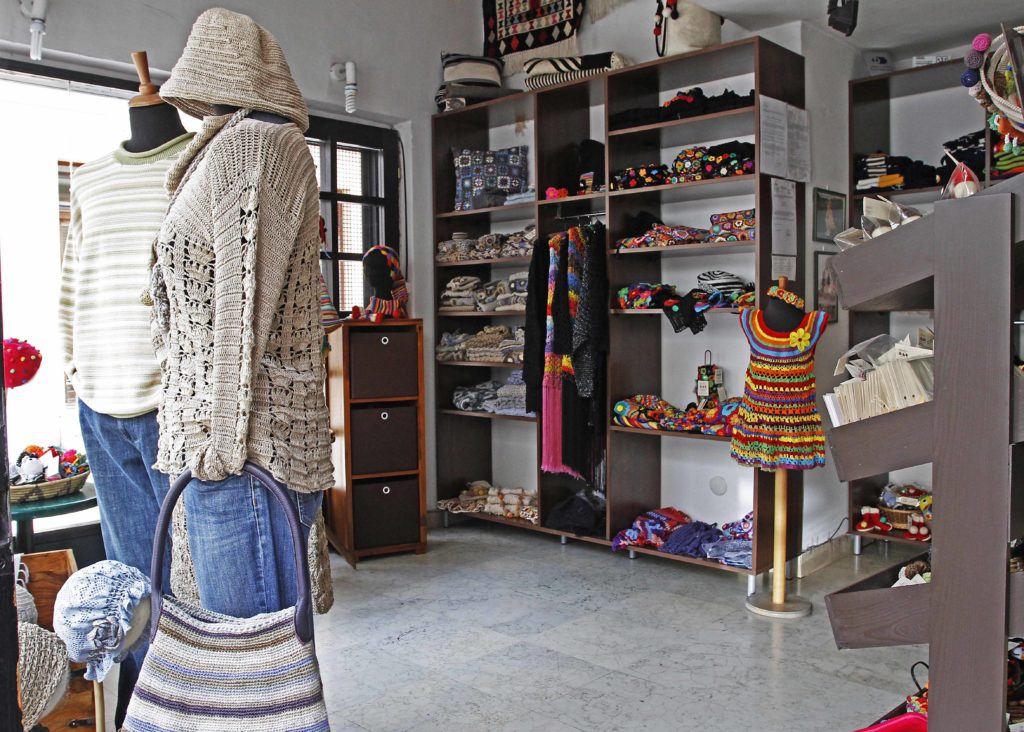
BH Crafts displays a wide assorment of products (Photo: BH Crafts)
Nermina Alic, who runs Mangala (Kovači 19, Sarajevo), became in 2007 the first woman in Sarajevo to own a coppersmith, typically a men’s business. The name of the shop recalls a symbolic household item traditionally used for lighting, and that is nowadays mostly found as a decorative item. Nermina also produces other traditional copper and brass products.
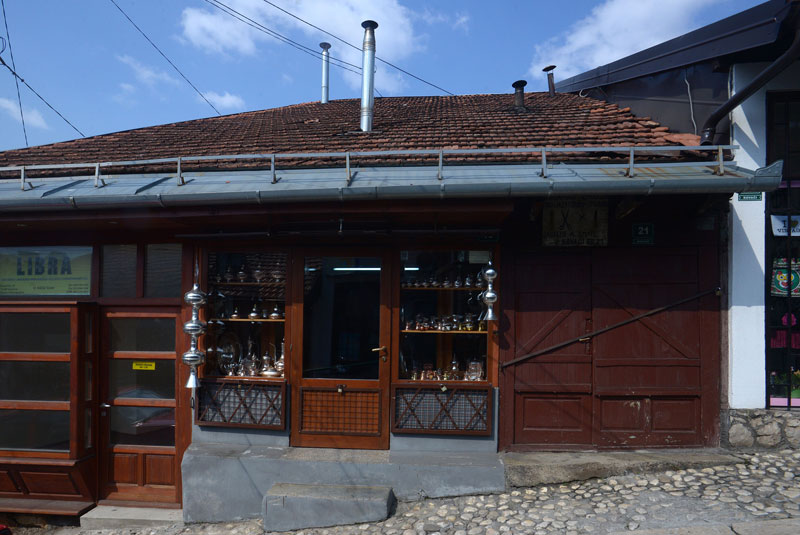
Mangala is run by Nermina Alic, the first woman in Sarajevo to own a coppersmith workshop (Photo: Mangala)
A family-run business since 1961, BećArt (Gazi Husref-begova 30, Sarajevo) is a filigree and silver workshop, which keeps up an ancient handicraft tradition. You will find beautiful jewellery here, where ornaments are made of silver or gold wire. Combining ancient techniques with modern design, the Becar family aims at preserving and continuing this endangered tradition.
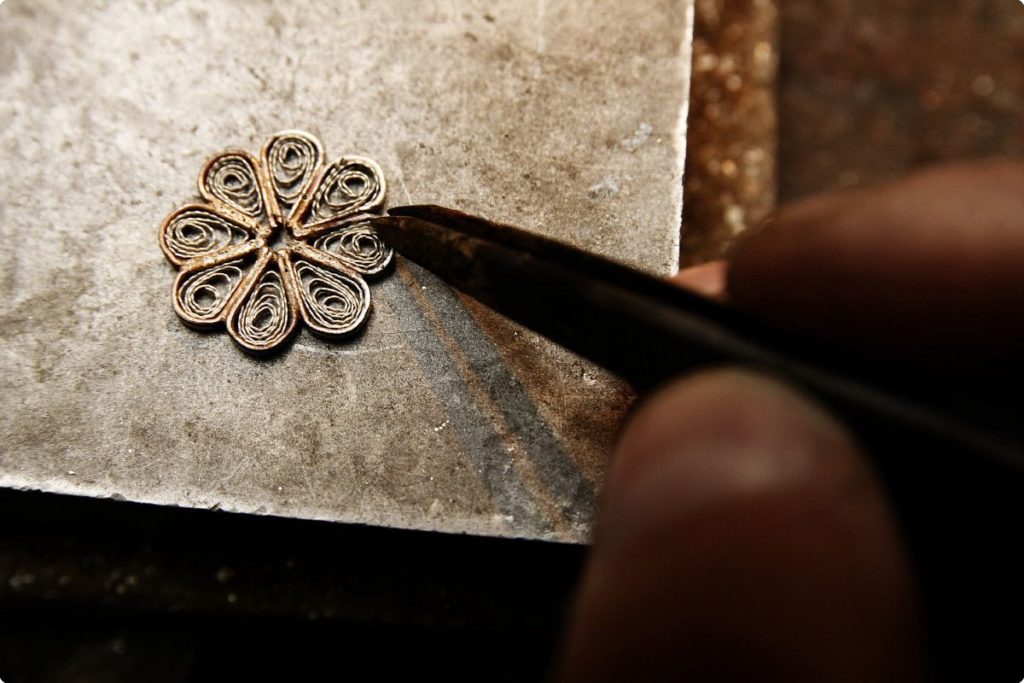
The Becar family keeps up an ancient craft tradition (Photo: BećArt)
Live music and nightlife
Jazzbina Sarajevo (Maršala Tita 38, Sarajevo) hosts regular jazz, blues and rock acts. Located near the Eternal Flame, Jazzbina’s urban vibes cater to a loyal clientele of music lovers who find the right musical accompaniment to their night here. DJ sets and occasional punk and funk bands are also included in the programme.
As its name might suggest, Underground Club (Maršala Tita 56, Sarajevo) is more focused on rock music. This place only opened in 2011, but it quickly became one of the top spots in Sarajevo’s nightlife. What it offers is simple: Flowing beer and rakija, frenzied live gigs and indulgent opening times. And a thick cloud of smoke when the room is crowded.
Cinemas Sloga (Mehmeda Spahe 20, Sarajevo) is a popular venue providing great ambience and guaranteed fun. With late nights held throughout the week, the listing programme is rich and varied. Pop, disco, r&b and student nights are some of the regular acts, while Latin Mondays are among the most popular events.
Beer and music is all one needs to know about the City Pub (Hadžiristića BB, Sarajevo). Its convenient location makes it popular among locals and tourists alike, all looking for an easy-going atmosphere to enjoy a few drinks and good live music. Expect mostly rock, jazz and pop bands.